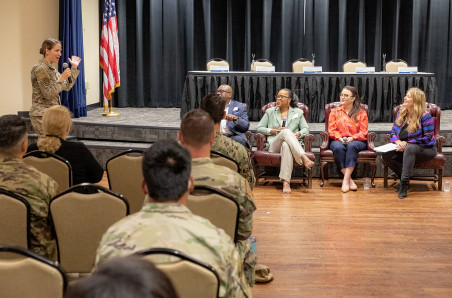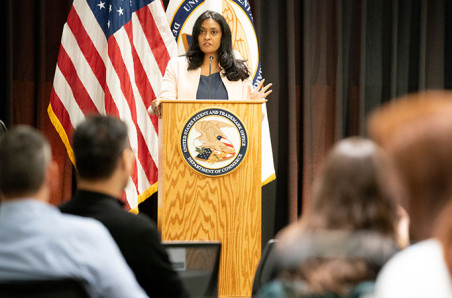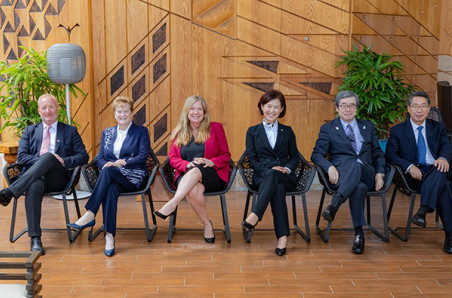
On World IP Day on April 26, Director Vidal met with representatives from the World Intellectual Property Organization, including Director General Daren Tang and Deputy Director Lisa Jorgenson (Photo by Patrick Barcia/USPTO)
Just getting started
Since I was sworn in a little over a month ago, we at USPTO have hit the ground running. I wanted to share an update with you.

Defining mission and vision
Our intellectual property system is the engine that propels our economy. Our nation's founders created this system to drive economic growth and foster a higher standard of living for all. Now more than ever, we need that growth and equity, and we need an intellectual property ecosystem that will cultivate an innovation mindset and be a catalyst for inclusive innovation, economic prosperity, U.S. competitiveness, national security, and world problem-solving. We need to incentivize and protect more innovation, especially in key technology areas, and bring that innovation to impact.
While we work collaboratively with those within the USPTO, which comprises over one quarter of the U.S. Department of Commerce's workforce, the Patent and Trademark Public Advisory Committees, sister agencies and stakeholders to develop the intellectual property roadmap to help propel our country forward, we are operating under a new, interim vision and mission. Our next step will be to roll out high level interim objectives for internal and public feedback.
Interim until final
We plan to accelerate change and communications by adopting interim processes and procedures while we work to finalize. As we do that, we encourage your feedback at every stage. We will provide mechanisms for input on the interim processes, and we will use those to adapt as necessary and shape our next steps. There will also be the formal mechanisms for providing input as we issue Requests for Comments and/or proceed through the rulemaking process.
Interim Director review
To advance our goal of promoting innovation through consistent and open decision-making and the issuance and maintenance of strong patents, we updated our interim Director review process for reviewing Patent Trial and Appeal Board (PTAB) final written decisions in inter partes review and post-grant review proceedings. I look forward to issuing a request for comments and formalizing the Director review process.
Providing 21st century service
Along with our Acting Commissioner for Patents Andrew Faile and our Chief Information Officer Jamie Holcombe, I wrote about our latest efforts to make it easier for patent applicants to file their applications in the DOCX format. Last year, the USPTO announced the requirement for applicants to transition to the DOCX file format and stressed the benefits of doing so. Some were concerned there might be potential rendering issues if applications contained complex drawings or formulas. Our recent blog post announced an interim option for applicants to file both in DOCX and with a backup PDF file to help promote confidence in the DOCX format.
We also announced that we will begin issuing electronic registration certificates and announced a proposed rule to require electronic filing of patent term extension applications.
Improving our processes
We announced that the Trademark Trial and Appeal Board (TTAB) is considering implementing a pilot program for holding Final Pretrial Conferences in certain inter partes (trial) cases to better manage and streamline opposition and cancellation proceedings that proceed to trial. The goal of the pilot is to save time and resources of parties and the TTAB, and to foster the effective and efficient presentation of evidence. We are encouraging stakeholders to provide feedback on the contours of the pilot by emailing TTABFeedback@uspto.gov.
Out in the legal community
I spoke at the Fordham IP Institute about my focus on creating economic prosperity through an intellectual property (IP) system that:
- Fosters, incentivizes, and protects innovation
- Is fair, accessible, and transparent to all
- Creates incentives and generates more innovation, especially in underserved communities and in key technology areas–and maximizes that innovation's widespread impact
Rethinking design protection
We announced the publication of our “Summary of public views on the article of manufacture requirement of 35 U.S.C. § 171.” The paper summarizes the responses we received about whether the USPTO's interpretation of the “article of manufacture” requirement for design patents should be reevaluated to incentivize and protect design innovation in new and emerging technologies, including projections, holographic imagery, and virtual and augmented reality. I highlighted this timely new report and the importance of design protection (We saw an 82% increase in design patent applications from 2009-2019!) in my remarks at the USPTO's Design Day, the design patent community's largest annual gathering. Given the rise and importance of designs and the different treatment of design protection across the globe, it is one of the areas at the top of our list to consider.
Harmonization
We issued a notice of proposed rulemaking to revise the rules of practice for submitting biological sequence data associated with disclosures of nucleotide and amino acid sequences in patent applications by incorporating by reference the provisions of Standard ST.26 into the USPTO rules. In addition to simplifying the process for applicants filing in multiple countries, a requirement to submit a single sequence listing in eXtensible Mark-up Language (XML) format will result in better preservation, accessibility, and sorting of the submitted sequence data for the public.

Director Vidal participated in an “invention challenge” with second-grade students at Cora Kelly Elementary School for Math, Science, and Technology in Alexandria, Virginia, in celebration of World IP Day on April 26. (Photo by Jay Premack/USPTO)
Incentivizing inclusive innovation
On April 26, the USPTO celebrated World IP Day, which focused on the theme “IP for a Better Future: Young Innovators.” I began the day by meeting with second-grade students at Cora Kelly Elementary School in Alexandria to discuss their own invention ideas, as part of our commitment to reach great minds at every age. A representative of the Department of Education joined us and started a discussion on how we can introduce more innovation education at the K-12 levels. I then joined Shira Perlmutter, Register of Copyrights and Director of the U.S. Copyright Office; and Daren Tang, Director General of the World Intellectual Property Organization, at the USPTO's World IP Day celebration to discuss how we can use our IP ecosystem to help innovative, energetic, and creative minds drive positive change. Later that afternoon, I spoke at the Licensing Executive Society International's World IP Day event, preceding a panel of past USPTO Directors, and I concluded the day by speaking at the USPTO's monthly event for K-12 educators that featured an engaging discussion on IP among USPTO interns in our work-based learning program through the Urban Alliance.

On May 5, the USPTO recognized the 27 visionary inventors who were inducted into the National Inventors Hall of Fame. (Photos by Jay Premack/USPTO)
On May 5, I had the honor of recognizing the achievements of the 2022 class of National Inventors Hall of Fame (NIHF) inductees. These 27 incredible inventors hold a collective 1,772 patents and counting, and represent fields and backgrounds from communication technology to health and medicine, agriculture, and workplace safety.
Notably, for the first time ever, two Black women were inducted into NIHF: Dr. Marian Croak, for the development of Voice over Internet Protocol (VoIP), which allows us to make calls directly from our computers or other WiFi-connected devices; and Dr. Patricia Bath (posthumous), for inventing laserphaco technology, which has improved the lives of millions of people suffering from vision problems by removing cataracts (Dr. Bath is also the subject of the USPTO's May Journeys of Innovation story). It was an honor to celebrate these trailblazing problem-solvers who inspire others through their persistence and brilliance. I encourage you to learn more about their accomplishments.

Director Vidal shared her vision on curbing counterfeiting and expanding access to the innovation ecosystem at the International Trademark Association's annual conference on May 4. (Photo by Jay Premack/USPTO)
Curbing intellectual property violations
I spoke to our trademark community at this year's International Trademark Association's annual conference in Washington, D.C., where I discussed our robust efforts to fight trademark fraud. I explained how we are addressing our inventory of unexamined applications and highlighted our “Go For Real” anti-counterfeiting campaign with the National Crime Prevention Council.
Bringing innovation to impact for the under resourced
I was excited to recognize the record number of patent practitioners and law firms that volunteered significant time to provide pro bono assistance to under-resourced inventors and small businesses through our Patent Pro Bono Program and the 21 regional programs that support it. In calling for broader participation in these programs by more practitioners and law firms, I noted that the work of those we recognized will make a real impact for our country, and we need to scale our programs and assistance. This is the key to unlocking U.S. competitiveness, creating jobs and economic prosperity, and fostering national security. For more information on participating in the program, visit the Patent Pro Bono Program page and click on your state to identify a regional program in your area, or email probono@uspto.gov.
Looking inward
As we work together to unleash America's potential, we are looking inwardly as well as outwardly.
On my first official day, April 14, I held a virtual town hall with thousands of our employees, where I answered questions and discussed my plans. I've been incredibly impressed with the hard work and diligence of USPTO staff and will continue listening to their thoughts on how to strengthen our Agency and, in turn, advance our nation's economic standing.
As we open our doors on May 25, I remain proud of our long-standing, flexible workplace policies and the role they play in fostering our successful USPTO community. Our strong and varied affinity groups also bring us closer together and give us the contacts, tools and resources we need to be successful and mentally healthy. And, though our agency is regularly recognized as one of the best places to work, we are going to do better. Going forward, we will study and implement leading-edge best practices, based on behavioral science research, for reshaping organizations to better promote diversity, equity, inclusion, accessibility, and opportunity. That work begins immediately.
We are always looking for great talent to join our team. Please stay posted for our announcements and please help us find great people to serve you and our mission.
Bilateral meetings and listening sessions
We have held a few weeks of bilateral meetings with other countries and listening sessions with stakeholders and others who could benefit from the innovation ecosystem. We walked away with a lot of great ideas for moving forward. We look forward to hearing from you during our upcoming listening sessions.
And we're just getting started. Over the next few weeks, some of my priorities include:
- Finalizing a study on regional demographics and the number of women patentees, as part of my focus on expanding innovation across socioeconomic and geographical lines—especially to reach those who have historically lacked access to opportunities to innovate
- Continuing to expand our Patent Pro Bono Program to make sure everyone has access to innovation
- Ensuring that our patent system protects key innovation while not incentivizing, protecting, or permitting activity that will thwart that impact—whether that is in the pharmaceutical space, in litigation practices, or in our PTAB proceedings
- Moving forward our discussions on patent eligibility
I look forward to hearing more from you and working together as we continue to protect, incentivize, and support innovation and expand the benefits of our innovation ecosystem throughout our country.
Engage with the Director and join the conversation on our social media channels.






